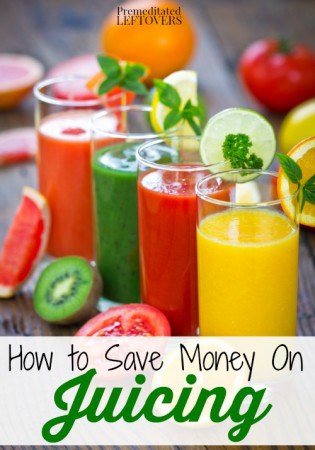If you are into juicing, you know all about how great it can feel to give your body a boost in nutrition and energy. One thing that can keep people back from starting to juice is the cost involved. You will need to buy a juicer, which can be expensive, and all those fresh fruits and vegetables, which can become costly. Here are some tips for saving money on juicing.
How to Save Money on Juicing
Buy your vegetables at farmer’s markets. If you are lucky enough to live in an area that has farmer’s markets, this can often be a great way to get organic and local as well as very fresh fruits and veggies at a great price.
Use some frozen vegetables and fruits. Most fruits and vegetables that are frozen are full of the same nutrients as fresh, but at a lower cost. This is especially true about those that are flash frozen. Just make sure to use them up quickly so they don’t get freezer burnt and lose vital nutrition and taste. Here are tips for freezing produce.
Make a juicing shopping list. Plan your recipes ahead of time according to what produce is on sale. Making a list when you go shopping will help you cut down on impulse purchases when shopping for your juicing supplies.
Juice in season. Vegetables and fruits have seasons when they are the cheapest. Do your juicing according to what is in season at the time. If you find a super great deal, make sure to freeze some for later. Here is a list of in-season produce.
Ask about a discount. This may work best at a smaller, local grocery store, but if you buy a lot of fruits and vegetables, you may be able to get a great discount for bulk buying. Be willing to show receipts from the past month or so to prove just how much you are buying. They may even let you order enough for yourself at a great discount and then you can come and pick it up all ready to go.
Buy low-priced staples for juicing. Spinach is generally not too expensive and neither are carrots and cucumbers. All of these make great ingredients to add to your smoothie concoctions. Build your recipes around these low cost staples.
Shop at warehouse clubs for your best produce buys. Places like Costco often have great buys available for bulk purchase, but be aware of unit prices as well as you may be able to get produce cheaper on sale at a regular store.
Check out Cash and Carry type shops if you have them in your area. These are open to the public restaurant supply stores that allow consumers to purchase products in restaurant sized bulk packs and charge a wholesale price for them.
Shop around for your juicer. If you are new to juicing, buy a cheaper model until you decide that juicing is right for you. You may also be able to find a barely-used juicer on Craig’s List. If you already own a blender, use it to make juice until you know you are committed enough to juicing to justify buying a juicer. Be aware that you may not have as fine of liquid and there may still be some small bits in your juice if you do it this way, however.
Use the Pulp. You do not have to discard the pulp, there are many ways to use the leftover pulp to add fiber to other recipes. You can add it to soups, spaghetti sauce, chili and much more. Here is a list of ways to use juicer pulp.
What are some of your favorite juicing recipes or ways you save on your juicing?
More Money Saving Tips
How to Save Money by Weighing Produce


Annie says
Hi there,
I am aware this is a one year old post, I still wanted to add something to it:
I recommend instead of juicing you could use a standard blender, add some water or milk or unsweetened juice to the fruits and mix it all up.
That way you have the whole fruit in your juice. Especially if you do this daily it is the most efficient way – and less time consuming since the cleansing of the blender is way quicker.
best
Annie
Alea Milham says
I think that is a great suggestion Annie! Especially if you are trying to get more fiber in your diet.